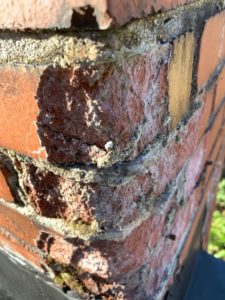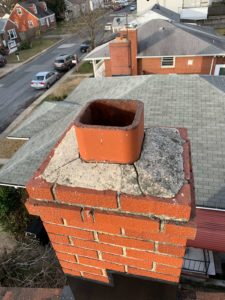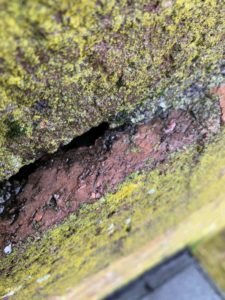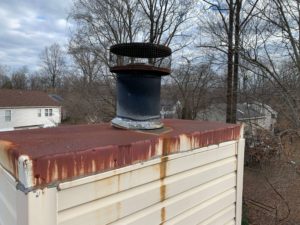 Chimney leaks can be a real nightmare, but fixing them is one of our specialties. Here’s what you need to know about why they occur, what the signs are, and how they can be prevented.
Chimney leaks can be a real nightmare, but fixing them is one of our specialties. Here’s what you need to know about why they occur, what the signs are, and how they can be prevented.
Why Do Chimney Leaks Occur?
Chimney leaks occur because all chimneys — whether masonry, a pipe coming through the roof, or a pipe enclosed in some kind of housing (metal or plywood covered in either cedar, aluminum, or vinyl siding) — all have points that come through the roof.
The problem is, there are different co-efficiencies of expansion between dissimilar material types. That means: as things heat up and cool, whether it’s from heating and using a chimney or from the outside atmosphere changing, things will expand and contract at different ratios. This creates movement and openings where the chimney comes through the roof and meets with the flashing or shingles.
Additionally, anything that’s exposed to the outside elements (rain, freeze/thaw, snow, sunlight) wears down over time. And because of the UV rays, the caulking or the tar or whatever they’ve put around the chimney or pipe will start to crack and wear away, creating a water entry point.
Other Common Causes of Leaks
 #1 Worn down chase covers, storm collars, or chimney caps
#1 Worn down chase covers, storm collars, or chimney caps
On the top of a factory-built fireplace chimney, there will almost always be what’s called a metal chase cover. It looks like the lid of a shoebox, flat on top with the four sides folding down over the siding. In the center, you’ll have a hole that the pipe passes through, and that’ll have a thing around it (like a lampshade) called a storm collar. Then, at the very top you’ll have a chimney cap.
All of these parts need to be sealed with some kind of cement, caulking, flash sealing, or other appropriate material. But over time, because of exposure to the elements, the material used will crack and wear down, or the movement will make it lose its flex point. When this happens, you’ll start to get water leaks.
You may also get galvanic corrosion. Many times, the chase covers put on by builders are made of galvanized metal. And when they’re exposed to the elements in the rain, they will rust out. The correct replacement for a rusted out chase cover would be a stainless steel or powder-coated stainless steel chase cover, so you don’t have to replace it a second time.
#2 Porous masonry
Masonry chimneys — whether brick, block, or stone — are big sponges. So every time it rains or snows, your masonry chimney soaks in that moisture. And when it soaks in the moisture, if the temperature goes below freezing (say that evening), then all that water in there freezes.
The problem is, when water freezes, it wants to expand. And if the next day, the temperature gets well above freezing, that water contracts, and you get that constant movement of expansion and contraction.
The bricks will want to slide on their mortar joints, and they’ll separate because of the different co-efficiencies of expansion between water and clay brick. The same thing will happen with stonework.
You’ll also get micro-fissures from bricks fracturing, which create even more openings for water to soak in. It’s kind of like a snowball running down a hill and picking up more snow — water accelerates the deterioration.
#3 Cracked crowns
The crown, which is the cement slab that’s poured on top of the chimney, is typically made with just the regular cement or mud that you lay bricks with. But these materials soak up a lot of moisture, which will make your crown crack, and allow moisture entry into the brickwork as well.
#4 Flashing failure
The flashing — whether on a masonry chimney or on a factory-built chimney — will have metal and some kind of barrier. Whether it’s a caulking or a tar-type sealer, these break down and expand and contract at different ratios as they heat and cool, creating water-entry points.
The Exterior Tell-Tale Signs of a Chimney Leak
 Some of the tell-tale signs of a leak which you’ll see on the exterior of your chimney and home include:
Some of the tell-tale signs of a leak which you’ll see on the exterior of your chimney and home include:
- Vegetation growth – We’ve seen all kinds of vegetation growth as a result of a water-soaked chimney, from black streaking on brickwork or siding to green vegetation growth and even little trees the size of a broom handle growing out of the masonry structure. The only way for something to grow in masonry is if it’s water-soaked, so if you see vegetation, there’s definitely a water problem.
- Watermarks and stains on the plywood roofing in the attic – If your chimney passes through the attic and you have a leak, watermarks and stains will likely be visible on the plywood roofing or roof trusses in your attic. Look for mold, mildew, and wood-rot.
The Interior Tell-Tale Signs of a Chimney Leak
Some of the tell-tale signs of a leak which you’ll notice on the interior of your home include:
- Water stains on the ceiling near your chimney – Look at your fireplace opening and follow it up to the ceiling. If you see an oval or round off-color (usually brown or tan) stain, you likely have a chimney leak.
- Swelling or rotting wood molding near the hearth – If your fireplace is in the basement and you have a leak, it’s very common to see swelling or rotting wood molding down low near the hearth. You may also see black discoloration on that wood or anywhere on the wall structure around it. When you start to notice these signs, it’s almost too late. It means you’re probably going to have to remove some sheetrock and insulation, and dry out the wall.
- Pinging sounds when it’s raining – If you have a factory-built fireplace chimney and you hear a pinging sound when it rains, you likely have a chimney leak. What you’re hearing is water coming in and hitting the top of the fireplace. That means water is either leaking through the chase cover, coming in around the storm collar or flashing, or you’ve got a piece of siding missing.
 Leaks are just another reason why the National Fire Protection Association (NFPA) and Chimney Safety Institute of America (CSIA) recommend annual chimney inspections. These inspections aren’t just checking to make sure the chimney is clean; they’re making sure nothing has significantly changed in the last year due to weather conditions, storms, tree branch strikes, or anything else.
Leaks are just another reason why the National Fire Protection Association (NFPA) and Chimney Safety Institute of America (CSIA) recommend annual chimney inspections. These inspections aren’t just checking to make sure the chimney is clean; they’re making sure nothing has significantly changed in the last year due to weather conditions, storms, tree branch strikes, or anything else.
Think of it as doing preventative maintenance, just like you would with your car. Once or twice a year, you may have your car put on a man-lift and looked at by a mechanic to make sure all the nuts and bolts are in place and you’re not dragging something around.
It’s the same with your chimney. When you have a CSIA-certified technician come out to do an inspection per national fire code and residential code and standards of care, they’re doing a once-over to make sure everything is as it should be.
Can Leaks Be Prevented or Are They Just a Part of Life?
Good news: leaks can be prevented. We specialize in fixing leaky chimneys, but we also specialize in preventing them. How do you prevent chimney leaks?
For masonry chimneys, they make a waterproofing agent that works like a Gore-Tex raincoat. It will not allow any water from the outside to be absorbed into the brickwork or the mortar joints, but it allows any moisture that’s trapped in the chimney or will be created in the future (from heating and cooling) to escape.
You will always have moisture in your chimney (because when hot meets cold, it creates water vapor) and it needs to wick away to the outside. There are specially formulated waterproofing agents that seal the chimney from the outside, but the most important thing to remember is that it needs to allow that moisture inside to wick away to the outside. Otherwise, your chimney’s going to rot out on the inside and you won’t know it until it’s too late.
So be selective with what you coat your chimney with. Never seal your chimney with a tar, and because some paints aren’t vapor permeable, we’d advise against paint as well. Because even though they may keep the water from coming in, they don’t allow moisture out. It would be like wearing a rubber raincoat in the middle of summer: you’re going to sweat in it and be just as wet as if you didn’t wear the raincoat and went outside.
For crowns (the cement slab on top of your chimney), there are special elastomeric sealing agents that can go on top. These have a polymer in them (basically like a plastic film) that works to keep rain out. But the polymer also allows these sealants to stretch, like a good pair of sweatpants on Thanksgiving. You know you’re going to eat a lot of food, so you’re going to wear your real comfortable sweatpants with a little bit of elasticity. Well, you know your chimney crown is going to move, expand, and contract as it heats and cools (either from outside temperature or from a fire in the fireplace) as well. Your chimney crown needs some elasticity so this movement can take place without cracking.
For your flashing, there’s a flash coating material that works in the same way. It will coat the flashing and keep water out, but also expand and contract as the metal, the brickwork, the mortar joints, and the shingles change temperature and expand at different ratios.
In other words: with the right products, there’s always a way to keep the moisture out. Of course, you’ll still need to have your system looked at on a yearly basis, because all of these materials have different warranties. Some are as long as 20 years, some are 10, and some are 7. You want to make sure you’re checking on your chimney on a regular basis, so you’ll get behind the 8 ball before any of these applications need to be reapplied.
If you see any signs or suspect you have a leak, or you’d like to talk with someone about waterproofing your chimney, contact a CSIA certified technician ASAP. We’re here to help!
